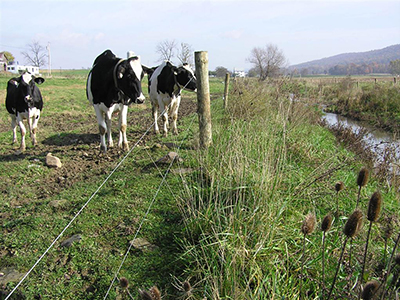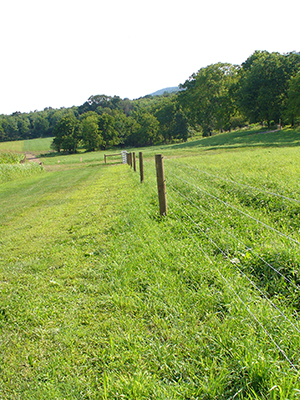Watershed Conservation
Streambank Fencing and Crossings
The Conservancy’s watershed conservation staff provides technical expertise in identifying and treating all forms of non-point source pollution, such as excess nutrients and fertilizers from agricultural operations and sediment from eroding streambanks. This type of pollution is the leading cause of water quality issues impacting our region’s waterways.

Our trained watershed staff provides technical assistance for water quality and riparian area monitoring, macroinvertebrate sampling, habitat evaluations and monitoring protocol development, among other areas of specialty. Our staff is also available to serve on project steering and technical committees, and advisory boards at the local, state or federal level.
Why Streambank Fencing and Stream Crossings Are Needed
Streambank fencing and stabilized stream crossings are approved best management practices that help improve water quality in streams flowing through agricultural lands. Fencing limits animals’ access to specific stream crossing points and thus decreases soil disturbance on the streambank. Stream crossings are gently sloped and stabilized areas that use rock to stabilize a crossing point for animals and machinery. They help prevent streambank and streambed erosion while providing access to fields and pastures.
Benefits of Streambank Fencing
Healthy Livestock
Fence and stream crossings may help reduce the risk of animal injury. Limiting livestock's access to streams reduces animals' contact with waterborne bacteria that may cause black leg, mastitis and other ailments.
Vegetation
Vegetation provides erosion control, wildlife habitat and flood control and acts as a buffer between the pasture and the stream, trapping runoff such as animal waste, pesticides, fertilizers and sediment. Shade from vegetation can also help regulate water temperature.
Improved Water Quality
Limiting livestock's access to streams prevents animal waste from entering the water source. The survival of everything from small organisms—such as mayfly larvae—to large organisms—such as brook trout—depend on clean waterways.
Natural Landscape
Buffers consisting of native trees, shrubs, grasses and wildflowers enhance the beauty of a farm.
 How We Can Help
How We Can Help
WPC’s Watershed Conservation Program works with the USDA Natural Resources Conservation Service, US Fish and Wildlife Service, PA Game Commission, county conservation districts and other organizations to provide the streambank fencing program. Watershed conservation staff will also work with the landowner to determine the costs that the program will cover.
Conservation Reserve Enhancement Program (CREP)
The Conservation Reserve Enhancement Program (CREP) provides eligible area farmers with financial and technical assistance to help them address conservation issues through the voluntary establishment of wetlands, hardwood trees and riparian buffer practices. Interested landowners can contact their local Farm Service Agency for enrollment.
For More Information:
Watershed Conservation Program
Western Pennsylvania Conservancy
1067 Philadelphia Street, Suite 101
Indiana, PA 15701
